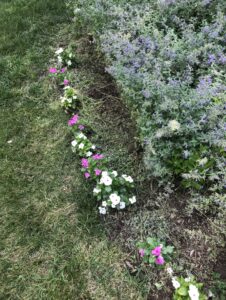Good Fortune–Today is mid-peak of the Summer bloom time, and most blooms will last until at least the beginning of October.
To get better sense of the gardens, we’ll begin with our four flower gardens–one bordering Connecticut Avenue; a second near the entrance to the building; then colors in the courtyard; and finally the small city-space at the property’s SouthEast corner
Connecticut Avenue–Bright Annuals and Sturdy Perennials
To grace the new welcome sign, this space has a number of great bloomers. Beginning at the outside, there are vincas. Delicate as they appear, these are the garden’s workhorses. We have two colors, alternating between a white with a small red dot and a mid-palette pink. They are planted late April-early May and remain bright until night temperatures fall into the low-40s-so for sure October. As beautiful as they keep, they are also very easy to maintain–just water, weed and enjoy.
They die in the Fall and must be replanted each Spring, thus classified as annuals For those interested in beginning a garden, vincas are great anchors
The violet foot-high plants are known as catmint. They are evergreen, or perennials, and only need weeding and thinning to survive. Their blooms also last until late Summer.
The tall multi-petaled auburn-colored flowers are known as coneflowers. If you look closely, petals have a red horizontal stripe at their base. As sun-time diminishes, the flower colors become more muted, but still interesting
There’s also a new tree planted just this year, which we believe is the ever-graceful crepe myrtle. These trees bloom mid-to-late Summer in colors ranging across white to lavender band.
It will likely bloom later this month.
Forest Hills Building Entrance–Variety, Color and Faithful Perennials
The most plentiful blooms here are begonias. Thanks to faithful tending by Joseph, they always brighten gardens and boost everyone’s morale. They are annuals and very dependent on bright sun. But they will remain cheerful until Summer’s end.
At each end of this garden are pale-apricot colored roses. Roses are so incredibly popular that growers have been able to develop truly spectacular varieties. On these bushes, which are nowhere near as complex as some of newer plants, it blooms THREE times per year. Their pudgy fragrant companions are lavenders, have been much beloved by bees and us people for thousands of years. We’ll have more on these and other herbs in a later issue.
Next to the building entrance, begonias are also featured but joined by small flowers-some bright pink and others white– named dianthus. They are small-flowered cousins to carnations. For as delicate and intricate as their flowers appear, they are perennials and flowers last well into Fall and return mid-Spring. They are hardy, faithful companions and always interesting
And we await two newcomers, bee balm and dahlias, the former (reportedly) attractive to hummingbirds and butterflies and the latter maybe the most spectacular–and demanding–of any garden plant. They are late-bloomers, July-August. So we shall see
Courtyard–Trees & Bishes: Hydrangeas, Phlox, Rhododendrons, Crepe Myrtles
Probably the most interesting space on campus. Here, flowers must share the glory with blooming bushes and trees. But this garden also has early flowers growing from bulbs. Even though tulips and daffodils are at a much smaller scale, their Spring appearances are (very) welcome after even mild Winters. But they are soon overwhelmed by two of the most spectacular cousins in any garden anywhere–azaleas and rhododendrons. They bloom from early to late Spring.
And followed by multihued hydrangeas whose blooms take the baton and bloom until mid-July.
Several new flowers have been added–vincas, marigolds and phlox, the latter arriving just this Summer. We were lucky to get ours thanks to a sharp-eyed Miles Lee who found them at a local nursery.
Presiding over this venue are several 25-foot crepe myrtles, with their midsummer blooms that make this one of the area’s most serene
Rear Garden–Herbs, Flowers and a Nice Place for Pause
Last, but no less interesting is the rear garden which also serves as a nice area to evaluate different plants, especially herbs. At the moment, it has the herbs lavender, basil, oregano and rosemary. It also serves as a place to test how plants stand up to challenges like squirrels and rabbits.
Since it is out of the way, it is also a nice place to take a break and watch the world go by for a few minutes
Thanks
The blog is meant to make your visits to the Forest Hills gardens enjoyable and more interesting. Suggestions are welcome
And welcome to these gardens
We’ll be back with more as the seasons unfold
The story was written by:
Bartley O’Hara, Forest Hills of DC resident






0 Comments